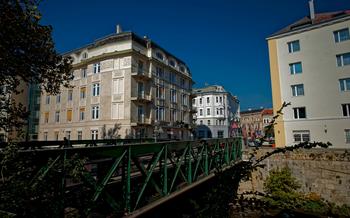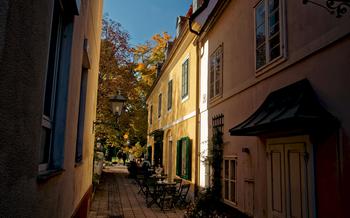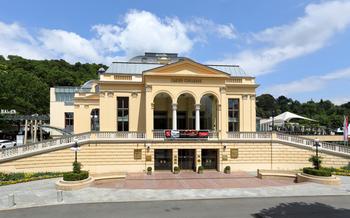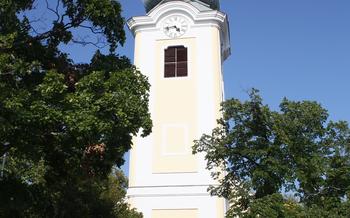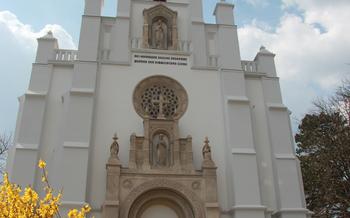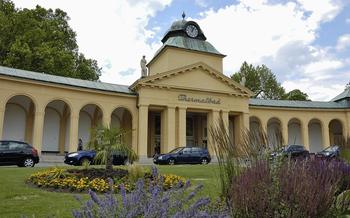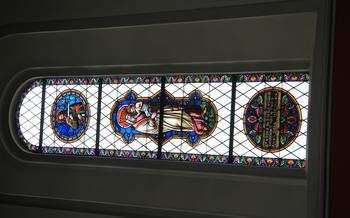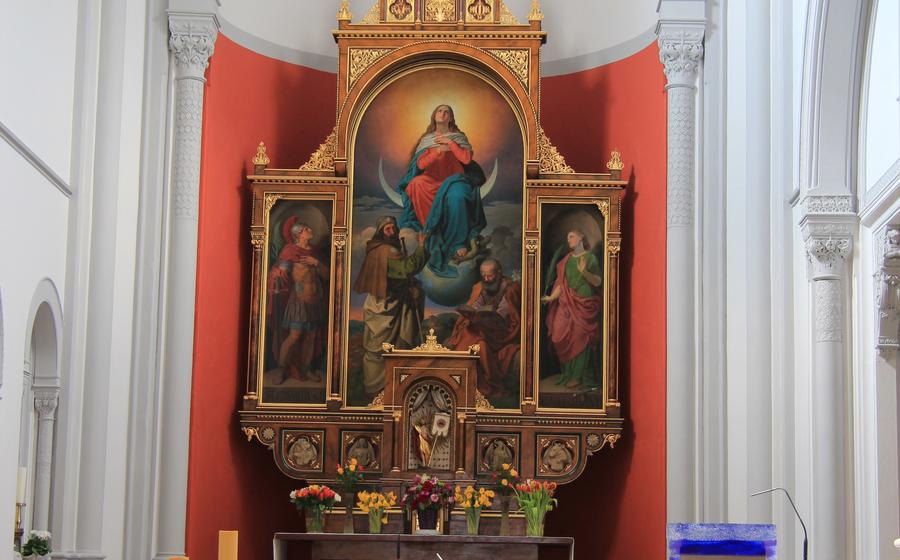
Glauberkreuzweg (Pilgrimage Path)
- A Pilgrimage Path with a Unique Charm
- The Stations of the Cross and Their Symbolism
- Following the Footsteps of Pilgrims
- A Journey of Reflection and Renewal
- Practical Information for Pilgrimage Walkers
- Exploring Bad Vöslau, a Thermal Springs Town
- Local Cuisine and Delicacies
- Day Trips from Bad Vöslau
- The Glauberkreuzweg in Different Seasons
- Pilgrimage Accommodation and Retreat Centers
- Cultural and Historical Significance
- Pilgrimage Services and Support
- Accessibility and Inclusivity
- Local Traditions and Customs
- Insider Tip: Exploring Hidden Gems
A Pilgrimage Path with a Unique Charm
The Glauberkreuzweg, nestled in the idyllic countryside of Bad Vöslau, Austria, is a pilgrimage path steeped in history and natural beauty. Conceived in 1700, this sacred trail winds its way through picturesque landscapes, connecting pilgrims with the spiritual essence of the region. Along its route, 14 intricately crafted stations depict the Stations of the Cross, offering a profound journey of reflection and contemplation. The path is not just a religious route but also an artistic and cultural treasure, inviting pilgrims and visitors alike to immerse themselves in its serene atmosphere and breathtaking surroundings.
The Glauberkreuzweg is more than just a pilgrimage path; it's an experience that touches the soul. As you walk along the path, surrounded by the tranquil beauty of nature, you can't help but feel a sense of peace and tranquility wash over you. The Stations of the Cross, with their intricate artwork and inscriptions, serve as powerful reminders of the sacrifice and suffering of Jesus Christ. The path offers a unique opportunity for pilgrims to connect with their faith, reflect on their own lives, and find solace and renewal.
The Stations of the Cross and Their Symbolism
The Glauberkreuzweg pilgrimage path features 14 stations, each depicting scenes from the Passion of Christ. Each station is marked by a cross and a relief sculpture or painting that illustrates the corresponding scene. The stations follow a chronological order, beginning with Jesus' condemnation by Pontius Pilate and ending with his crucifixion and resurrection.
The artwork and inscriptions at each station are designed to evoke emotions and inspire contemplation. The scenes depict the physical and emotional suffering endured by Jesus, as well as the compassion and empathy of those who accompanied him on his journey to Calvary. The inscriptions provide biblical references and thought-provoking messages that encourage pilgrims to reflect on the significance of Christ's sacrifice and its relevance to their own lives.
Some of the notable stations include the fifth station, which depicts Jesus being helped to carry his cross by Simon of Cyrene. This station reminds pilgrims of the importance of offering help and support to those who are struggling or in need. The eighth station, where Jesus meets the women of Jerusalem who weep for him, highlights the empathy and compassion that Jesus felt for others, even in his own suffering.
The twelfth station, where Jesus dies on the cross, is a powerful reminder of the ultimate sacrifice that Jesus made for humanity. It encourages pilgrims to reflect on the depth of God's love and the hope of eternal life through Christ's resurrection, depicted in the fourteenth and final station.
Overall, the Stations of the Cross along the Glauberkreuzweg provide a visual and spiritual narrative that deepens the pilgrim's understanding of Christ's suffering and its significance for their own faith journey.
Following the Footsteps of Pilgrims
Pilgrimage holds a significant place in the cultural and religious traditions of Austria, and the Glauberkreuzweg is a particularly revered pilgrimage path. People from all walks of life are drawn to this sacred route for various reasons. Some seek spiritual fulfillment, seeking a deeper connection with their faith and a chance for introspection and reflection. Others embark on the pilgrimage as a form of penance or to pray for a specific intention. For many, it is a way to connect with their heritage and the rich history of pilgrimage in the region.
Pilgrims often share personal stories and experiences that highlight the transformative power of the Glauberkreuzweg. Some recount profound spiritual awakenings, while others speak of finding solace and healing along the path. The shared journey and the sense of community among pilgrims create a unique atmosphere of support and camaraderie. Undertaking a pilgrimage can be a deeply rewarding experience, offering opportunities for personal growth, renewal, and a renewed appreciation for the simple things in life.
A Journey of Reflection and Renewal
The Glauberkreuzweg is more than just a pilgrimage path; it is an opportunity for quiet contemplation, reflection, and renewal. As you walk along the path, surrounded by the beauty of nature and the tranquility of the forest, you'll find yourself drawn into a deeper connection with your inner self. The Stations of the Cross, each with its own unique artwork and inscriptions, provide opportunities to reflect on the life and teachings of Jesus Christ and their relevance to your own life.
The pilgrimage offers a chance to escape the distractions of everyday life and reconnect with your spiritual side. As you walk in silence, you'll find yourself more attuned to the sounds of nature, the breeze on your skin, and the peace within your own heart. The journey itself becomes a metaphor for the spiritual journey we all take in life, as we strive to overcome obstacles, find forgiveness, and ultimately reach our destination.
Pilgrims who have walked the Glauberkreuzweg often speak of the profound impact it has had on their lives. They describe a sense of inner peace, a renewed connection with their faith, and a deeper appreciation for the simple things in life. Whether you're a devout Christian or simply seeking a transformative experience, the Glauberkreuzweg offers a unique opportunity for reflection and renewal.
Practical Information for Pilgrimage Walkers
The Glauberkreuzweg pilgrimage path offers a challenging yet rewarding journey for walkers of all levels. The path is approximately 10 kilometers in length, with an elevation gain of 300 meters. The walk typically takes between 3 and 5 hours, depending on your pace and the number of breaks you take.
The starting point of the pilgrimage is the pilgrimage church in Bad Vöslau. From there, the path leads through the town and into the surrounding countryside. The route is well-marked with signs, so you can easily follow the path without getting lost.
It is advisable to wear comfortable walking shoes or hiking boots, as the path can be uneven in places. Also, dress in layers so that you can adjust to changing weather conditions. Be sure to bring a water bottle and some snacks to keep yourself hydrated and energized during the walk.
There are several places to stay in Bad Vöslau, including hotels, guesthouses, and private accommodations. If you are planning to walk the pilgrimage over several days, you may want to book your accommodation in advance.
There are also several restaurants and cafes in Bad Vöslau where you can stop for a meal or a drink. The town is also home to a number of shops where you can buy souvenirs and other items.
Exploring Bad Vöslau, a Thermal Springs Town
Bad Vöslau, a charming town nestled in the heart of Lower Austria, is renowned for its thermal springs and rich history. Its strategic location at the foothills of the Vienna Woods and proximity to Vienna make it an ideal destination for those seeking relaxation, exploration, and cultural immersion.
Bad Vöslau's thermal springs have been a source of rejuvenation and healing for centuries. Visitors can indulge in the town's thermal baths, which offer a variety of pools, saunas, and spa treatments. The thermal waters are believed to have therapeutic properties, making them a popular destination for those seeking relief from various ailments.
Beyond its thermal springs, Bad Vöslau boasts several cultural attractions. The Kurpark, a beautifully landscaped park, serves as a tranquil oasis in the heart of the town. Visitors can stroll along its paths, admire the colorful flowerbeds, and relax by the serene pond. The local museum, Stadtmuseum Bad Vöslau, offers insights into the town's history, showcasing artifacts and exhibits that tell the story of its past.
Bad Vöslau's cultural offerings extend to music and the arts. The town hosts regular concerts, festivals, and exhibitions, showcasing local and international talent. Visitors can enjoy performances ranging from classical music to contemporary theater, immersing themselves in the town's vibrant cultural scene.
Whether you're seeking relaxation in thermal springs, exploring cultural attractions, or indulging in local delicacies, Bad Vöslau offers a delightful blend of history, nature, and charm. Its proximity to Vienna makes it an ideal base for exploring both the city and the surrounding region, ensuring a memorable and enriching travel experience.
Local Cuisine and Delicacies
Bad Vöslau and the surrounding region offer a tantalizing array of culinary delights, blending traditional Austrian cuisine with local specialties. Indulge in hearty dishes like Wiener Schnitzel, a crispy breaded cutlet, or savor the delicate flavors of Tafelspitz, boiled beef served with horseradish sauce. Don't miss the region's famous pastries, such as the mouthwatering Sachertorte, a rich chocolate cake, or the delectable Apfelstrudel, a flaky pastry filled with apples and cinnamon.
For a taste of local specialties, try the Bad Vöslauer Weintraubenhuhn, a chicken dish cooked in white wine and grapes, or the Bad Vöslauer Spargel, a succulent asparagus dish. Pair your meal with a glass of the region's fine wines, such as the aromatic Riesling or the robust Zweigelt.
To fully immerse yourself in the local culinary scene, visit one of Bad Vöslau's charming restaurants or cafes. Many offer outdoor seating, allowing you to soak up the town's vibrant atmosphere while savoring your meal. Whether you're looking for a traditional Austrian tavern or a modern bistro, you're sure to find something to satisfy your taste buds in Bad Vöslau.
Day Trips from Bad Vöslau
Bad Vöslau is surrounded by a wealth of nearby destinations and attractions, offering plenty of opportunities for day trips and excursions.
Baden bei Wien: A Historic City
Just a short distance from Bad Vöslau lies the historic city of Baden bei Wien. Known for its elegant architecture, thermal springs, and rich cultural heritage, Baden is a popular destination for visitors from all over the world. Stroll through the charming streets, admire the beautiful buildings, and soak in the thermal waters at one of the many spas.
Vienna Woods: Natural Beauty and Hiking Trails
The Vienna Woods, a vast and scenic forest area, are easily accessible from Bad Vöslau. With its rolling hills, lush forests, and picturesque villages, the Vienna Woods offer a paradise for hikers, cyclists, and nature enthusiasts. Explore the numerous hiking trails, discover hidden waterfalls and viewpoints, and enjoy the tranquility of the natural surroundings.
Mödling and Gumpoldskirchen: Charming Towns
The towns of Mödling and Gumpoldskirchen are located in close proximity to Bad Vöslau and offer their own unique charm. Mödling, with its medieval castle and lively town center, is a popular destination for day-trippers. Gumpoldskirchen, known for its wine production and picturesque vineyards, invites visitors to sample the local wines and explore the surrounding countryside.
These are just a few of the many destinations within easy reach of Bad Vöslau. With its convenient location and excellent transportation links, Bad Vöslau serves as an ideal base for exploring the surrounding region.
The Glauberkreuzweg in Different Seasons
The Glauberkreuzweg pilgrimage path offers a unique and transformative experience throughout the year, as the changing seasons bring their own distinct charm and beauty to the route.
In the vibrant hues of autumn, the path is adorned with a tapestry of golden leaves and russet hues, creating a picturesque backdrop for reflection and contemplation. The crisp air and gentle breeze add to the serenity of the walk, making it an ideal time to immerse oneself in the tranquility of the surroundings.
Winter transforms the Glauberkreuzweg into a magical winter wonderland, with snow-covered landscapes and sparkling ice crystals adorning the path. The serene silence of the snow-covered forest creates a mystical atmosphere, inviting pilgrims to connect with the spiritual essence of the journey.
Spring brings new life and energy to the path as the landscape awakens from its winter slumber. The vibrant green foliage, blooming flowers, and the sweet melodies of birdsong create a sense of renewal and rebirth, making it an uplifting time to embark on a pilgrimage.
Summer offers warm, sunny days and long hours of daylight, allowing pilgrims to fully appreciate the natural beauty of the surroundings. The lush greenery, fragrant wildflowers, and the gentle hum of insects create a harmonious symphony that enhances the spiritual experience of the walk.
Regardless of the season, the Glauberkreuzweg pilgrimage path offers a profound and transformative experience for those seeking peace, reflection, and inner growth. The changing seasons add their own unique charm to the journey, making each pilgrimage a unique and memorable experience.
Pilgrimage Accommodation and Retreat Centers
Pilgrims seeking overnight accommodation along the Glauberkreuzweg have several options to choose from. Pilgrimage hostels, guesthouses, and monasteries offer comfortable stays for those seeking a peaceful and spiritual retreat. These accommodations often provide basic amenities such as shared rooms, bathrooms, and communal dining areas, creating a sense of community among pilgrims. Some guesthouses also offer private rooms for those desiring more privacy.
For a more immersive experience, retreat centers and spiritual retreats are available in the area. These centers offer a range of programs and services designed to facilitate spiritual growth and reflection. Pilgrims can participate in guided meditations, workshops, and prayer sessions, as well as receive spiritual guidance and support. Retreat centers often provide comfortable lodging, delicious vegetarian meals, and access to serene meditation spaces.
When planning your pilgrimage, it is advisable to book your accommodation in advance, especially during peak pilgrimage seasons. This will ensure that you have a place to stay after a long day of walking. Many pilgrimage hostels and guesthouses offer online booking services for your convenience.
Cultural and Historical Significance
The Glauberkreuzweg holds immense cultural and historical significance, serving as a testament to the deep-rooted religious traditions and heritage of Austria. This pilgrimage path has been a beacon of faith for centuries, attracting countless pilgrims who sought spiritual enlightenment and connection with the divine. The path's creation in 1728 marked a pivotal moment in the region's religious history, and its enduring legacy continues to inspire and captivate visitors to this day.
The Glauberkreuzweg is not merely a religious site; it is also a cultural treasure that showcases the region's artistic and architectural prowess. The 14 stations along the route are adorned with intricate carvings, sculptures, and inscriptions that depict the Stations of the Cross with remarkable detail and symbolism. These artistic masterpieces serve as a testament to the skill and devotion of the local craftsmen who created them.
Moreover, the Glauberkreuzweg is deeply intertwined with local legends and folklore. Stories of miracles, divine interventions, and answered prayers have been passed down through generations, adding an air of mystery and wonder to the pilgrimage experience. These tales have become an integral part of the region's cultural tapestry and continue to captivate the imaginations of pilgrims and visitors alike.
Pilgrimage Services and Support
The Glauberkreuzweg is a popular pilgrimage destination, and there are a number of services and support available to pilgrims. These services include:
-
Pilgrimage guides: There are a number of pilgrimage guides and tour operators who can help you plan and organize your pilgrimage. These guides can provide you with information on the route, the stations of the cross, and the history and significance of the pilgrimage.
-
Organized group pilgrimages: If you would prefer to walk the pilgrimage with a group, there are a number of organized group pilgrimages available. These pilgrimages are typically led by a spiritual guide or leader who can help you to deepen your experience of the pilgrimage.
-
Resources and support for pilgrims: There are a number of resources and support available to pilgrims, such as maps, guidebooks, and spiritual guidance. These resources can help you to prepare for your pilgrimage and to make the most of your experience.
Accessibility and Inclusivity
The Glauberkreuzweg pilgrimage path is committed to providing an inclusive and accessible experience for all pilgrims. Wheelchair-accessible routes are available for those with mobility challenges, ensuring that everyone can participate in this sacred journey. These routes are well-maintained and designed to provide a smooth and enjoyable experience for pilgrims of all abilities.
For those seeking additional support, pilgrimage guides and tour operators offer specialized services catering to individuals with specific needs. These services can include assistance with transportation, accommodation, and tailored itineraries. Organized group pilgrimages and guided tours also provide a supportive environment for pilgrims to connect with others and share their experiences.
Detailed maps, guidebooks, and spiritual guidance are available to ensure that pilgrims have the resources they need to navigate the path safely and meaningfully. These resources provide information on accessible routes, rest stops, and points of interest along the way. By providing these resources and services, the Glauberkreuzweg pilgrimage path strives to create an inclusive and welcoming environment for all pilgrims, regardless of their abilities or circumstances.
Local Traditions and Customs
The Glauberkreuzweg is deeply embedded in the local culture and traditions of Bad Vöslau and the surrounding region. The pilgrimage path is a symbol of faith and devotion for many local residents, and the annual pilgrimage attracts thousands of visitors from across Austria and beyond.
Pilgrims often start their journey with a blessing at the local church, and they may carry a special pilgrim's staff or wear a pilgrim's badge. Along the way, they may encounter local people offering food, drinks, or words of encouragement. It is customary for pilgrims to greet each other with a friendly "Grüß Gott" (May God greet you).
The pilgrimage path is also a place of cultural expression. Local artists and artisans have contributed to the creation of the Stations of the Cross, and the path is often decorated with flowers and other offerings. Pilgrims may also encounter local musicians or choirs performing traditional Austrian folk music or religious hymns.
To fully embrace the local traditions and customs, it is important to be respectful and mindful of the religious significance of the pilgrimage path. Visitors should dress modestly and avoid loud or disruptive behavior. It is also important to be aware of the local customs regarding photography and videography.
By observing local traditions and customs, pilgrims can deepen their understanding of the cultural and religious heritage of the Glauberkreuzweg and enhance their overall pilgrimage experience.
Insider Tip: Exploring Hidden Gems
Beyond the main pilgrimage route, Bad Vöslau and its surroundings offer a treasure trove of hidden gems for those willing to explore off the beaten track. For a truly immersive experience, venture into the picturesque vineyards that blanket the surrounding hills, where you can savor local wines at charming wineries. Nature enthusiasts will delight in the nearby nature reserves, where hiking trails meander through enchanting forests and offer breathtaking panoramic views.
Seek out the hidden chapels and shrines tucked away in the countryside, each with its unique story and spiritual significance. For a taste of local history, visit the medieval castle ruins that dot the landscape, offering a glimpse into the region's rich past. And be sure to sample the local cuisine at traditional Austrian taverns, where you can indulge in hearty dishes prepared with fresh, seasonal ingredients.
With a little curiosity and a willingness to wander, you'll discover the hidden gems that make the Glauberkreuzweg pilgrimage truly special. Embrace the opportunity to connect with the local culture, savor the flavors of the region, and create lasting memories that will stay with you long after your journey ends.
